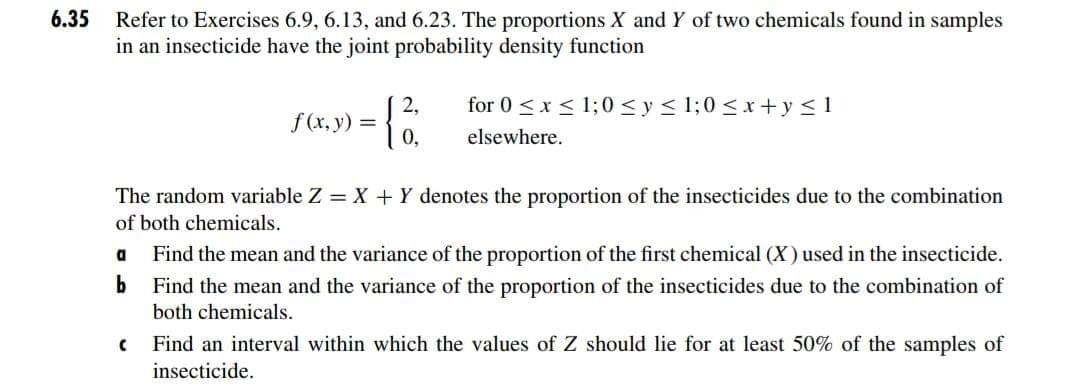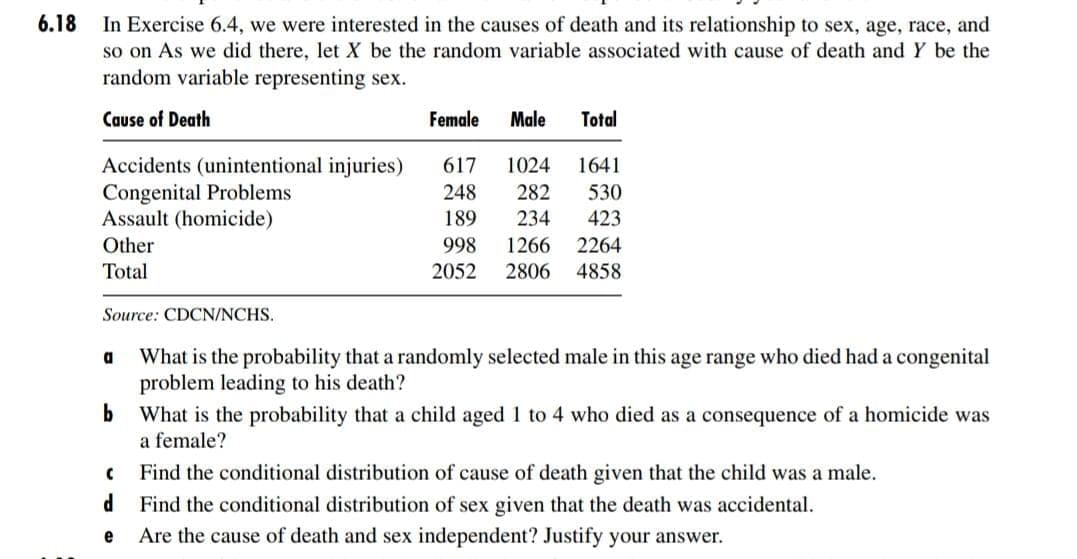What is the probability that a randomly selected male in this age range who died had a congenital problem leading to his death? b What is the probability that a child aged 1 to 4 who died as a consequence of a homicide was a female? Find the conditional distribution of cause of death given that the child was a male.
What is the probability that a randomly selected male in this age range who died had a congenital problem leading to his death? b What is the probability that a child aged 1 to 4 who died as a consequence of a homicide was a female? Find the conditional distribution of cause of death given that the child was a male.
Holt Mcdougal Larson Pre-algebra: Student Edition 2012
1st Edition
ISBN:9780547587776
Author:HOLT MCDOUGAL
Publisher:HOLT MCDOUGAL
Chapter11: Data Analysis And Probability
Section: Chapter Questions
Problem 8CR
Related questions
Question
100%

Transcribed Image Text:6.35
Refer to Exercises 6.9, 6.13, and 6.23. The proportions X and Y of two chemicals found in samples
in an insecticide have the joint probability density function
2,
for 0 <x < 1;0 <y < 1;0 <x+y <1
f (x, y) =
0,
elsewhere.
The random variable Z = X + Y denotes the proportion of the insecticides due to the combination
of both chemicals.
a
Find the mean and the variance of the proportion of the first chemical (X) used in the insecticide.
b
Find the mean and the variance of the proportion of the insecticides due to the combination of
both chemicals.
Find an interval within which the values of Z should lie for at least 50% of the samples of
insecticide.

Transcribed Image Text:6.18
In Exercise 6.4, we were interested in the causes of death and its relationship to sex, age, race, and
so on As we did there, let X be the random variable associated with cause of death and Y be the
random variable representing sex.
Cause of Death
Female
Male
Total
Accidents (unintentional injuries)
Congenital Problems
Assault (homicide)
617
1024
1641
248
282
530
189
234
423
Other
998
1266
2264
Total
2052
2806
4858
Source: CDCN/NCHS.
What is the probability that a randomly selected male in this age range who died had a congenital
problem leading to his death?
What is the probability that a child aged 1 to 4 who died as a consequence of a homicide was
a female?
Find the conditional distribution of cause of death given that the child was a male.
Find the conditional distribution of sex given that the death was accidental.
e
Are the cause of death and sex independent? Justify your answer.
Expert Solution
This question has been solved!
Explore an expertly crafted, step-by-step solution for a thorough understanding of key concepts.
Step by step
Solved in 2 steps

Recommended textbooks for you

Holt Mcdougal Larson Pre-algebra: Student Edition…
Algebra
ISBN:
9780547587776
Author:
HOLT MCDOUGAL
Publisher:
HOLT MCDOUGAL

Holt Mcdougal Larson Pre-algebra: Student Edition…
Algebra
ISBN:
9780547587776
Author:
HOLT MCDOUGAL
Publisher:
HOLT MCDOUGAL